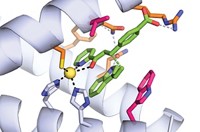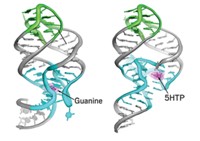Advertisement
Grab your lab coat. Let's get started
Welcome!
Welcome!
Create an account below to get 6 C&EN articles per month, receive newsletters and more - all free.
It seems this is your first time logging in online. Please enter the following information to continue.
As an ACS member you automatically get access to this site. All we need is few more details to create your reading experience.
Not you? Sign in with a different account.
Not you? Sign in with a different account.
ERROR 1
ERROR 1
ERROR 2
ERROR 2
ERROR 2
ERROR 2
ERROR 2
Password and Confirm password must match.
If you have an ACS member number, please enter it here so we can link this account to your membership. (optional)
ERROR 2
ACS values your privacy. By submitting your information, you are gaining access to C&EN and subscribing to our weekly newsletter. We use the information you provide to make your reading experience better, and we will never sell your data to third party members.
Synthesis
Tackling Enzyme Catalysis One Piece At A Time
Protein design strategy focuses on one aspect of catalysis, such as active-site nucleophilicity, at a time
by Celia Henry Arnaud
April 21, 2014
| A version of this story appeared in
Volume 92, Issue 16

Enzyme design has been a mixed bag. The strategy has generated excitement because it has yielded new enzymes that don’t exist in nature. But it has also led to disappointment because those enzymes have fallen far short of the activity of natural enzymes.
Breaking free of nature’s limited enzymatic tool kit could aid the synthesis of biofuels, pharmaceuticals, and other chemicals. To create new enzymes, researchers design the enzymes computationally, produce them in bacteria, and test their activity.
The test has been overall catalytic performance, and the conventional approach has tackled enzyme catalysis as a whole. That approach works, but not as well as researchers would like. “We have been able to design enzymes for many different chemical reactions,” says David Baker, a professor of biochemistry at the University of Washington, Seattle, and a pioneer in the field. “But those designed enzymes have not been anywhere near as active as naturally occurring enzymes.”
Fed up with mediocre enzymes, Baker decided to take a step back and tackle the problem a piece at a time. Last year, his group designed proteins that excel at binding a given ligand (Nature 2013, DOI: 10.1038/nature12443). Now they’ve shifted their focus to designing proteins that optimally activate nucleophiles in the active site. In the process, they’ve gotten some of the best matches seen yet between computational designs and the resulting proteins.
Baker’s research group collaborated with Benjamin F. Cravatt’s group at Scripps Research Institute California to design and optimize proteins with active sites in which a serine and two other amino acids work together to catalyze a reaction (Nat. Chem. Biol. 2014, DOI: 10.1038/nchembio.1498).
They based the designed proteins on serine hydrolases, which use a nucleophilic serine residue to hydrolyze ester, amide, or thioester bonds in proteins or other molecules. That serine residue is normally activated by a histidine and an aspartic acid; collectively, these three collaborating amino acids are known as the catalytic triad. An active site that requires three precisely positioned residues such as these is a more complex design problem than has previously been tackled.
Perhaps even more daunting is the challenge of activating a serine residue. Previously designed enzymes have tended to involve amino acids that are easier to activate. Cysteine, for example, has a pKa of ~8. Serine has a much higher pKa of ~13. “Shifting the pKa of serine to the point that it reacts strongly is way more chemically challenging,” Baker says.
To meet that challenge, Baker’s team used Rosetta, a computational design program they’d previously formulated, to create proteins with idealized serine-containing catalytic triads. They then produced these proteins in bacteria. They assessed nucleophilicity with fluorophosphonate probes that react irreversibly with the activated serine. Ultimately, they chose a promising candidate, designated OSH55, for additional optimization.
As part of that optimization, the researchers used Rosetta to build a variety of hydrogen-bonding networks that riff off of the traditional catalytic triad. Four of these were quite active. One used a serine-histidine-histidine triad as observed in some viral enzymes, and another used a catalytic quartet of serine, histidine, asparagine, and arginine with an even larger hydrogen-bonding network.
Crystal structures revealed that the hydrogen bond networks in these four proteins were nearly identical to those in the design model. Achieving this level of precision is a significant milestone for protein design, Baker says.
Even inactive designs had lessons for the researchers. Many of them had loop structures that ended up disrupting the active site. The researchers conclude that secondary structures such as helices are a key component of active designs.
Such preorganization of the active site helps lock the crucial residues in place for activation of the serine nucleophile. For example, the catalytic quartet is wedged beneath a helix, Baker says. “Those residues really have nowhere else to go,” he adds.
“Introducing more than two residues that function concertedly has always been a challenge, and here it has been met,” says Ivan V. Korendovych, an assistant professor of chemistry at Syracuse University who also works in protein design and directed evolution. “To me this highlights a shift in the design field.” A combination of computational design and directed evolution may result in better catalysts than either alone, he explains.
Baker plans to continue dissecting the enzyme design process. He wants to use protein scaffolds designed from scratch rather than retrofitting natural protein scaffolds.
“As the designed binding site becomes more and more complex, it becomes increasingly unlikely that a naturally occurring protein exists with the required backbone geometry,” Baker says. “It may be that there’s no natural, already existing backbone to which you can simply graft side chains to make that site. If you’re building custom backbones from scratch, you can ultimately have everything in place.”





Join the conversation
Contact the reporter
Submit a Letter to the Editor for publication
Engage with us on Twitter